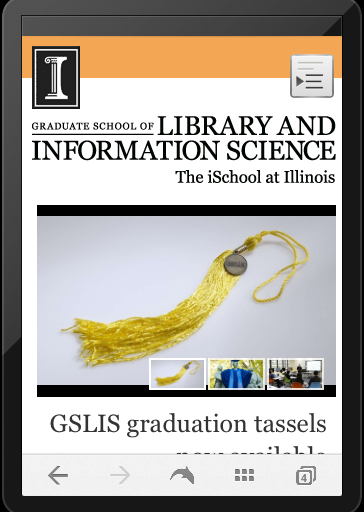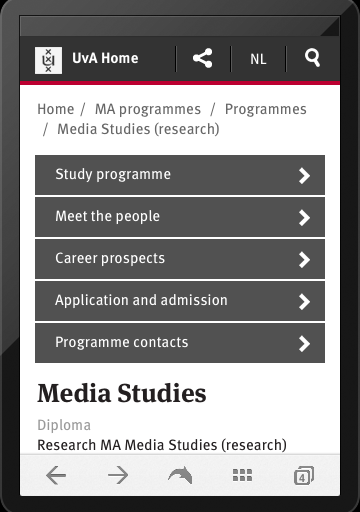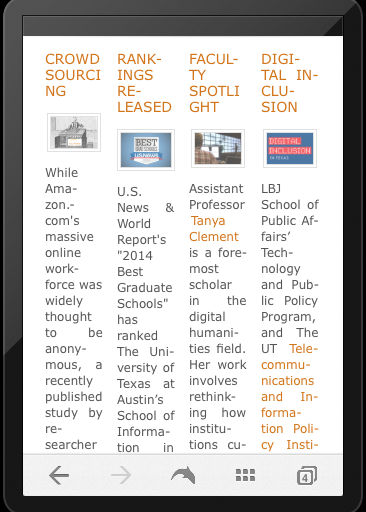Although I use iPad, which the mobile Safari and Chrome always download the iPad version, I could download the Dolphin browser iPhone version to mimic the viewport of iPhone to have applicable mobile phone experience.
Since our midterm project is on making MCDM website mobile, I thought might as well take a look on other academic institute’s website and see how they appear.
Most of the major institutions such as Stanford, Harvard, and UCLA had configured their main homepage mobile friendly. However, if you deep dive and take a look at departments’ website, it’s totally different and chaotic. Innovative and prestige programs like MIT Media Lab and UCLA Computer Science doesn’t have a mobile website or responsive design. This made me wondered, what is the percentage for a department to have a mobile compatible website?
 |
| MIT Media Lab and UCLS CS website weren't mobile friendly |
To find out the answer, the iSchools worldwide were probably the best entities to observe. In my opinion the iSchools should be specialized in information system management, web development, and user experience. They are the pioneers in building bridges between human and the Internet. There’s even an iSchools.org organization dedicated to the iSchools of the world. It’s better (and easier) to examine the 41 departments which have joined iSchools.org to gain understanding and learn pros and cons from their design. Ironically, the iSchool.org itself has a major flaw if you browse through your mobile phone. Its responsive design made its mobile page pop out a HUGE menu icon, which takes scroll 3~4 pages and it’s another 2~3 pages to find the link after open the menu tab.
http://ischools.org/
The result was quite surprising - only 9 out of 41 iSchools have their web site made mobile friendly. Means if you visit an iSchool’s webpage through mobile phone, less than 22% of chances it would appear as a mobile site. Furthermore, not every mobile website turned out to be fine. Just liked the iSchools.org, there were pages have their functions or buttons misplaced, or information of contents appeared in a hideous crowded way.
 |
| iSchool.org, it's a menu tab, not a list of links |
Here are the 9 iSchools that have their website go mobile, and few comments on them.
Responsive site – Use a menu button to direct as main navigation
Singapore Management University: average website
University of Illinois-Graduate School of Library and Information Science (GSLIS):
Menu button redirect to bottom of page, where all the navigation tabs are.
University of Maryland, Baltimore County (UMBC)-Department of Information Systems: Long list of verbose options, in a bad way. However I once saw a tornado warning on top of page, useful.
 |
| U of Illinois, the menu button directs you to bottom of page |
Responsive site – Assign tool bar or tab on top of page as main navigation
University of Amsterdam-Graduate School of Humanities (Archives and Information Studies): Clean, simple, very good on making contrast between different elements.
University of Maryland-College of Information Studies: Very simple, clean page
University of Melbourne-Melbourne School of Information: The layout was not designed, everything is not organized.
University of Texas, Austin-School of Information: Good design on labels, but the events got cramped, shown in an uncomfortable way.
University of Washington-Information School: The tabs are the same as full webpage version. But a dropdown list pop out on mobile page, specific for finding information, really handy.
 |
| U of Amsterdam, nice responsive design, although in full page mode it's kinda quirky |
 |
|
U of Texas in Austin, do you like to read in this way? |
Dedicated Mobile Site
University of North Carolina-School of Information and Library Science: It's a web app, you could tell difference by compare the views with desktop browser. Offer install as a web app to your phone's screen on first time entry. Very clean, like U of Amsterdam. The shortest in page's height.
 |
| U of North Carolina, web app! |















